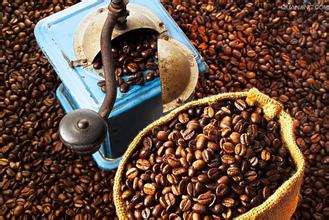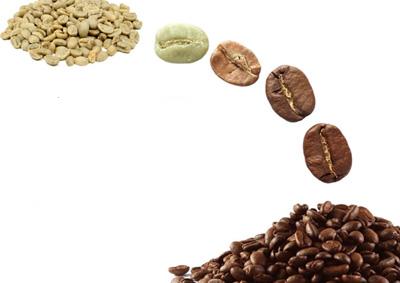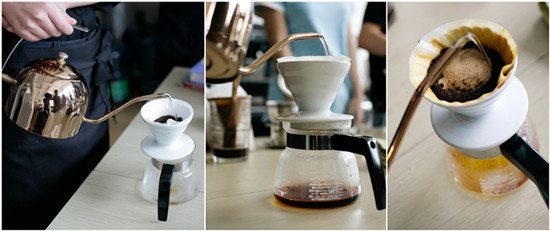Coffee Quality: Factors Affecting the Taste of a Cup of Coffee-From Crop To Cup
It has been known that the factors that affect the taste of a cup of coffee are raw beans (60%), roasting (30%) and extraction (10%). So let's take a look at the whole process of coffee life, that is, from a seed to a cup of coffee, to understand each factor on the taste of coffee one by one.
Raw beans: good materials can make a good taste-this is an immutable truth in the catering world. The quality of raw coffee beans is the key to determine the taste of coffee, so how to determine the quality of raw coffee beans?
First, variety. The world of difference between Arabica and Roberta needless to say here, Roberta's inferior varieties determine that it can only be used to process instant coffee and large-scale low-quality commercial mixed beans. And even within the large varieties of Arabica, there are many small varieties, such as Bourbon, Iron pickup, Kaddura, Katimo and so on. Although they are all Arabica species, they have great differences in taste. The older the varieties are, the richer the flavor is. In recent decades, variety improvements to improve yield and resistance to diseases and insect pests often ignore the taste of coffee. For example, the relatively high yield of Cartimo and the variants of Columbia and Kenya ruiru11, compared with the traditional varieties, is obviously light and has obvious miscellaneous and astringent tastes.
Second, the planting process. From seedling raising to cultivation, in the whole growth process of coffee trees, how to grasp the appropriate supply of water and fertilizer, proper pruning and weeding, and appropriate pest control need to be adjusted in time according to the local climatic conditions and weather conditions. Neglect of management, insufficient supply of water and fertilizer or abuse of chemical fertilizers will affect the quality of coffee, and then affect the taste of coffee.
Third, picking. This step is a very critical step. Only ripe fruits can be picked, because those unripe beans and overripe and rotten fruits not only affect the appearance and grade of raw beans, but also cause uneven roasting in roasting, and in a cup of coffee is the main source of miscellaneous flavor, astringency and some pungent taste.
Fourth, processing. The water quality in the washing process, the sanitary condition of the fermentation tank, the maintenance of the fermentation process and the control of fermentation time are all important factors affecting the taste of raw beans. Although the dry processing is relatively easy to operate, the cleanliness and dryness of the drying field will also affect the taste of raw beans. Coffee beans can easily absorb the peculiar smell of the ground so that the cup is mixed with soil flavor and miscellaneous odor. If hung on the wet ground, it is easy to make raw beans moldy. After processing, the moisture content of raw beans should reach 13%. If the drying is not enough, the raw beans are easy to be damp and moldy, while excessive drying is easy to damage and affect the flavor.
Fifth, packaging and safekeeping. After a long and fine process of breeding, cultivation, picking, processing and grading, the high-quality raw beans still have a long way to go before they are delivered to the baker, and this period is also a very important step for maintaining high-quality raw beans. Although raw beans can be stored for two years or more than baked raw beans, good preservation conditions are a prerequisite. In order to facilitate ventilation and heat dissipation, raw beans are usually packed in gunny bags, and during the long shipping process, it is very important to maintain stable humidity and temperature in the container. if this is not guaranteed, it is easy to destroy raw beans due to the influence of moisture during transportation.
Baking: the high-quality raw beans obtained after careful management and maintenance in the previous steps will give birth to a second life in the baking process, that is, the fire will give birth to a second life. from green, hard, tasteless raw beans to brown, aroma-rich raw beans, this process has a decisive impact on the play of taste.
First of all, the professional standards of bakers and roasters. Unlike baked bread and dried fruit, roasted coffee beans are edible as long as they are cooked, but they are not hot or overroasted when baking coffee beans will destroy a pot of beans. therefore, a stable roaster and the roaster's expertise is necessary here, not everyone can do baking, and not any roaster can play the original taste of coffee.
Secondly, the degree of baking. Even for the same kind of coffee beans, different roasting degrees can cause great differences in taste. For example, strong oxalic acid and raw bean taste will be shown in Kenya,cinnamon roasting, acidity will be stimulated after medium roasting, high roasting degree will show strong acidity and bright style, and the taste will become richer. City roasting degree will make the acidity softer, sweetness and bitterness more balanced, and the overall taste rich and balanced. However, the depth of full city makes kenya lose all its beautiful acidity, leaving only strong bitterness and sweetness. if we further bake french and italian, we will get glossy black beans, and it is impossible to judge whether it is kenya by taste alone.
Third, firepower adjustment in baking. According to the adjustment of baking time and firepower, baking can be divided into slow baking pie and fast baking pie. Slow baking pie usually takes more than 20 minutes at a time, while fast baking pie usually ends baking in 10 minutes or less. There is no way to tell which is right or wrong, but the roasted coffee has its own advantages and disadvantages in terms of taste and style. Fast-baked coffee generally has obvious acidity and bright style, but the thickness and richness of alcohol will be slightly lower, slow roasting can give play to the deep taste and high mellow of coffee, but it is not easy to make coffee muddy and dull, bitter strong and lack of acidity.
Extraction: although it accounts for only 10% of the factors, because it is in the final check step, and the extraction methods and instruments are diverse, the extraction process is more artificially influenced, so the factors that affect the taste in this link appear to be more complex and subtle.
Extraction utensils: the same coffee beans, using Italian machines, hand bubbles, French presses, mocha pots, or original Turkish pots, taste completely different, and no machine can decisively produce the best taste. The key is to choose the right machine according to the situation of the coffee beans.
Extraction time: no matter what kind of equipment, there is a time control to complete the extraction within an appropriate time range to ensure the taste of coffee. If the time is too short, the extraction is insufficient, and if the time is too long, the extraction is excessive. We can get a perfect cup of espresso in 25 seconds, but it is impossible to make a good cup of hand-brewed coffee in 25 seconds. If the production of espresso is extended to 1 minute, it will not be a qualified espresso.
Degree of grinding: too rough grinding is easy to lack of extraction, too fine grinding is easy to over-extract, and proper adjustment of coarse grinding can avoid the extraction of too much bitterness and strong taste, and appropriate adjustment of fine grinding can show a richer and more delicate taste.
Extraction temperature: in general, low temperature is easy to exert the acidity of coffee but easy to lack of extraction, high temperature can extract more flavor but easy to extract strong bitterness, different coffee beans, utensils also have different temperature requirements, this also depends on the specific situation.
Baristas' operation: whether it is apparatus selection, temperature adjustment or time control, it is done by baristas, so the level of baristas is a key, whether they can grasp the principle of the influence of various factors on taste, and whether they can judge the situation and adjust correctly at the right time, which determines whether baristas can extract the complete taste of coffee.
Throughout the whole life process of coffee, in fact, from the initial planting and processing, to the transportation and storage of raw beans, to roasting and extraction, the whole process is operated by people, including coffee farmers, coffee purchasers, transporters, cup reviewers, roasters, baristas, and the taste of the last cup of coffee is also determined by the coffee drinker. from this point of view, people are the dominant factor in the taste of coffee. In every link of coffee from seed to cup, under stable natural conditions, if you can play the positive role of a good person, you can naturally achieve a good cup of coffee, while any mistake in the middle will affect the perfect performance of the coffee in the cup.

Source:
The blog of the world of coffee with two bottles of water
Important Notice :
前街咖啡 FrontStreet Coffee has moved to new addredd:
FrontStreet Coffee Address: 315,Donghua East Road,GuangZhou
Tel:020 38364473
- Prev

Introduction to the main points of coffee roasting knowledge: coffee bean roasting theory (1)
(reprint) grab a handful of coffee and smell raw beans, there is always a pungent smell, which is very different from the charming smell of coffee in your impression. However, after roasting "fragrance" correctly, raw beans will emit the strongest aroma in the world. The small high-altitude Arabica coffee raw beans are like a warehouse full of chemicals. At present, scientists have identified more than 2,000 known ingredients.
- Next

Introduction to coffee brewing by hand: introduction to hand-brewing coffee making-posture
Among the many methods of making coffee, hand brewing can not only give full play to the rich and fresh aroma of coffee in taste, maintain the pure taste and rich and soft taste of coffee, and maximize the personality of coffee, but also has the advantages of easy operation, easy to learn and easy to make. The appliance is easy to manage and so on. But this does not mean that making coffee by hand means brewing coffee at will without any basis.
Related
- What is the meaning of lactic acid fermentation with coffee bean treatment?
- How to judge the state of foam by sound?
- How does the latte pull out the unicorn pattern? Come to get for a little trick to improve the flower pull!
- Will flower pulling affect the taste of the latte?
- Do you know the history of coffee?
- The difference between honey treatment and sun washing what is raisin honey treatment?
- What kind of milk can a novice use to make coffee foam to keep the foam longer? The correct method and skills of milking tutorial sharing
- Why do washed coffee beans taste sour? Flavor characteristics of washed Coffee
- Introduction to the skill of how to practice the size and height of water injection around the circle of hand-brewed coffee
- How do beginners practice coffee flower drawing from scratch?

